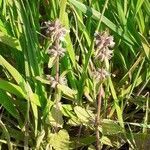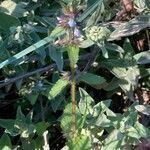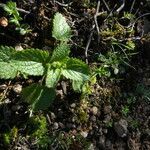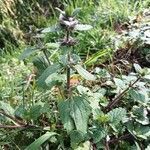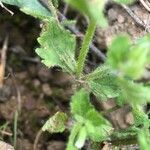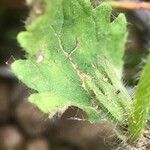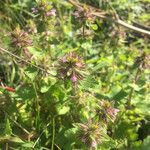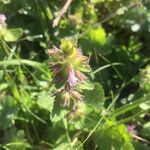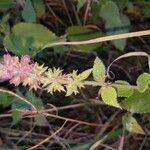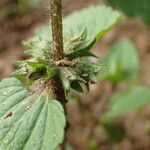Annual herb branching from the base; stems erect or decumbent, simple or branched, 0.2-0.4 m long, hispid-pilose with long spreading hairs. Leaves petiolate; blade broadly ovate, 20-30 x 10-20 mm, appressed-pilose on both surfaces, apex rounded, base shallowly cordate to truncate, margin crenate to crenate-serrate; petiole up to 10 mm long. Inflorescence of several verticils, lax below, crowded towards the apex; verticils (2-)4-6-flowered; bracts leaf-like below, becoming smaller and subequal to the calyx above. Calyx hirsute with long multicellular hairs and some gland-tipped hairs, 6-7 mm long. Corolla scarcely longer than the calyx, mauve; tube 5 mm long; upper lip 1.5 mm long; lower lip 2 mm long.
Hairy, non-aromatic annual with stem to c. 50 cm tall, often much less. Petioles often > lamina in basal lvs, very short in upper lvs. Lamina of basal and upper lvs 1-4 × 0.7-2.5 cm, oblong, ovate or suborbicular, evenly crenate; base truncate to cordate; apex rounded. Bracts sessile, otherwise similar to uppermost foliage lvs. Calyx c. 5 mm long, hairy; teeth ± = tube, linear-lanceolate, acuminate. Corolla 6-7 mm long, pink, somewhat hairy outside; tube = or slightly < calyx; upper lip small, not hooded, < lower lip. Nutlets 1.5-2 mm long, broad-obovoid, bluntly angled, often with blackish, irregular tubercles.
Annual herb, 0.2-0.4 m high; stems erect or decumbent, simple or branching from base; hispid-pilose with long, spreading hairs. Leaves petiolate, broadly ovate, 20-30 x 10-20 mm, base shallowly cordate to truncate, apex rounded, margins crenate to crenate-serrate; appressed-pilose on both surfaces. Inflorescence of several verticils, lax below, crowded towards apex; verticillasters 2-6-flowered. Flowers very small, up to 7 mm long, mauve. Calyx hirsute with long, multicellular hairs and some gland-tipped hairs. Corolla scarcely longer than calyx; tube 5 mm; upper lip 1.5 mm and lower lip 2 mm long.
Taprooted annual; stems diffuse or decumbent, 2–6 dm, sparsely hirsute; lvs broadly ovate, 2–4 cm, broadly obtuse or rounded at the summit, coarsely serrate, truncate or subcordate at base; petioles of the main lvs a third to half as long as the blade; cal-lobes nearly as long as the tube; cor anthocyanic to white, 6–8 mm, scarcely exceeding the cal; 2n=10, 20. Native of Europe, now an occasional weed from Me. to Va. and casually inland. July–Oct.
Hairy annual to 40 cm. Leaves petiolate, broadly ovate, toothed. Flowers in verticils, calyx softly hairy, corolla scarcely longer than calyx, mauve or white.
